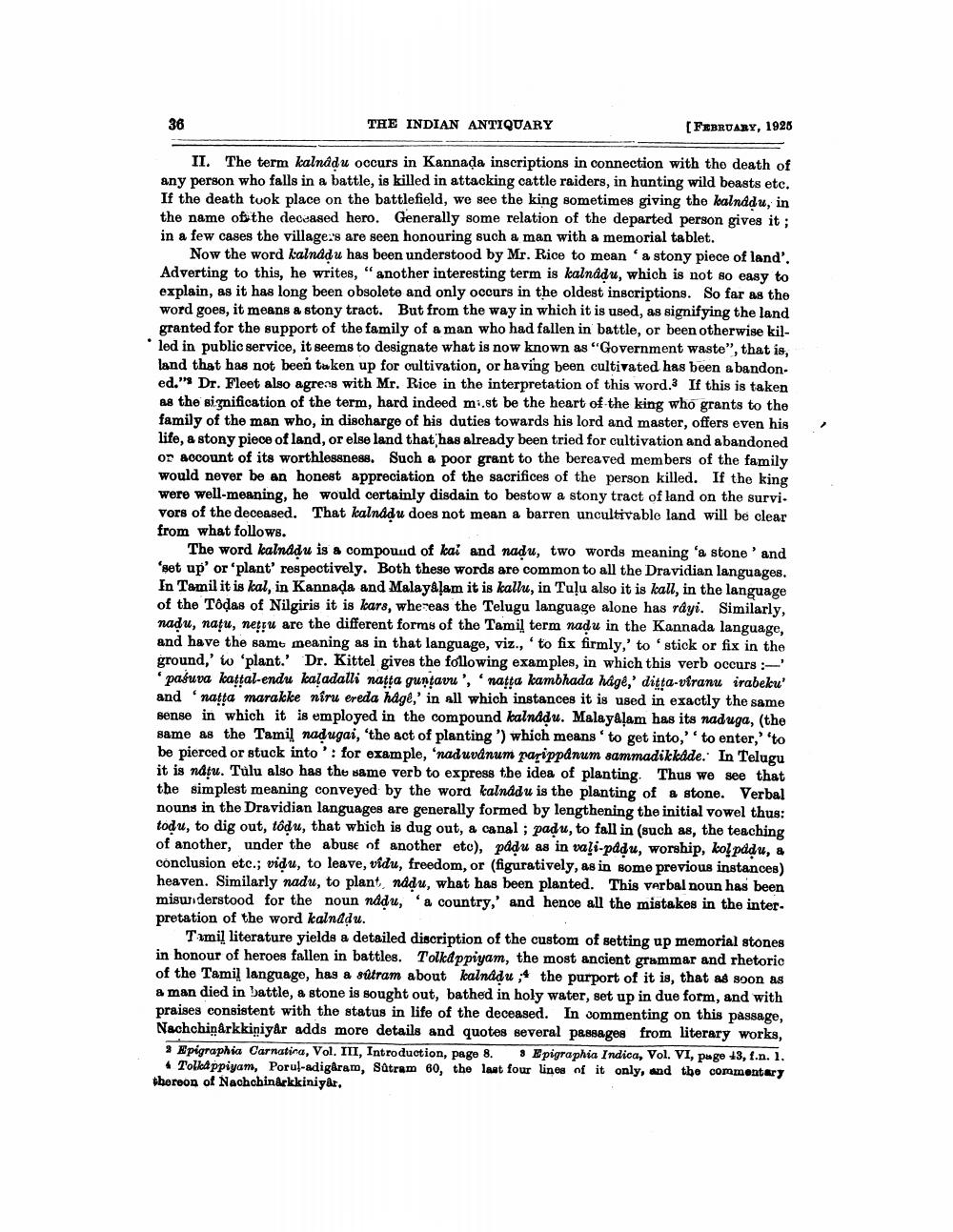________________
36
THE INDIAN ANTIQUARY
[FEBRUARY, 1926
II. The term kalnádu occurs in Kannada inscriptions in connection with the death of any person who falls in a battle, is killed in attacking cattle raiders, in hunting wild beasts etc. If the death took place on the battlefield, we see the king sometimes giving the kalnadu, in the name of the deceased hero. Generally some relation of the departed person gives it ; in a few cases the villages are seen honouring such a man with a memorial tablet.
Now the word kalnadu has been understood by Mr. Rice to mean ' a stony piece of land'. Adverting to this, he writes, "another interesting term is kalnádu, which is not so easy to explain, as it has long been obsolete and only occurs in the oldest inscriptions. So far as the word goes, it means a stony tract. But from the way in which it is used, as signifying the land
granted for the support of the family of a man who had fallen in battle, or been otherwise kil*led in public service, it seems to designate what is now known as "Government waste", that is,
land that has not been taken up for oultivation, or having been cultivated has been a bandon. ed." Dr. Fleet also agress with Mr. Rice in the interpretation of this word. If this is taken as the signification of the term, hard indeed mi.st be the heart of the king who grants to the family of the man who, in discharge of his duties towards his lord and master, offers even his life, a stony piece of land, or else land that has already been tried for cultivation and abandoned Or account of its worthlessness. Such a poor grant to the bereaved members of the family would never be an honest appreciation of the sacrifices of the person killed. If the king were well-meaning, he would certainly disdain to bestow a stony tract of land on the survi. vors of the deceased. That kalnadu does not mean a barren uncultivable land will be clear from what follows.
The word kalnadu is a compouud of kai and nadu, two words meaning 'a stone' and 'set up' or 'plant respectively. Both these words are common to all the Dravidian languages. In Tamil it is kal, in Kannada and Malayalam it is kallu, in Tuļu also it is kall, in the language of the Tôdas of Nilgiris it is kars, whereas the Telugu language alone has rayi. Similarly, nadu, natu, netu are the different forms of the Tamil term nadu in the Kannada language, and have the same meaning as in that language, viz., ' to fix firmly,' to stick or fix in the ground,' to'plant.' Dr. Kittel gives the following examples, in which this verb occurs
pasuva kattal-endu kaladalli natta guntavu', 'natta kambhada hage,' ditta-viranu irabeku' and natta marakke niru ereda hage,' in all which instances it is used in exactly the same sense in which it is employed in the compound kalnddu. Malayalam has its naduga, (the same as the Tamil nadugai, 'the act of planting ') which means to get into,'' to enter,' 'to be pierced or stuck into ': for example, 'naduvanum parippanum sammadikkade. In Telugu it is ndtu. Tulu also has the same verb to express the idea of planting. Thus we see that the simplest meaning conveyed by the word kalnadu is the planting of a stone. Verbal nouns in the Dravidian languages are generally formed by lengthening the initial vowel thus: todu, to dig out, tódu, that which is dug out, a canal ; padu, to fall in (such as, the teaching of another, under the abuse of another etc), pádu as in vali-padu, worship, kol padu, a conclusion etc.; vidu, to leave, vidu, freedom, or (figuratively, as in some previous instances) heaven. Similarly nadu, to plant, nadu, what has been planted. This verbal noun has been misunderstood for the noun nadu, a country, and hence all the mistakes in the inter. pretation of the word kalnddu.
Tamil literature yields a detailed discription of the custom of setting up memorial stones in honour of heroes fallen in battles. Tolkappiyam, the most ancient grammar and rhetoric of the Tamil language, has a sútram about kalnadu ,4 the purport of it is, that as soon as a man died in battle, a stone is sought out, bathed in holy water, set up in due form, and with praises consistent with the status in life of the deceased. In commenting on this passage, Nachchinarkkiniyar adds more details and quotes several passages from literary works, 2 Epigraphia Carnatira, Vol. III, Introduction, page 8. 3 Epigraphia Indica, Vol. VI, page 3, .n. 1.
Tolkappiyam, Porul-adigâram, Sūtram 60, the last four lines of it only, and the commentary theroon of Nachchin&ckkiniyar.




